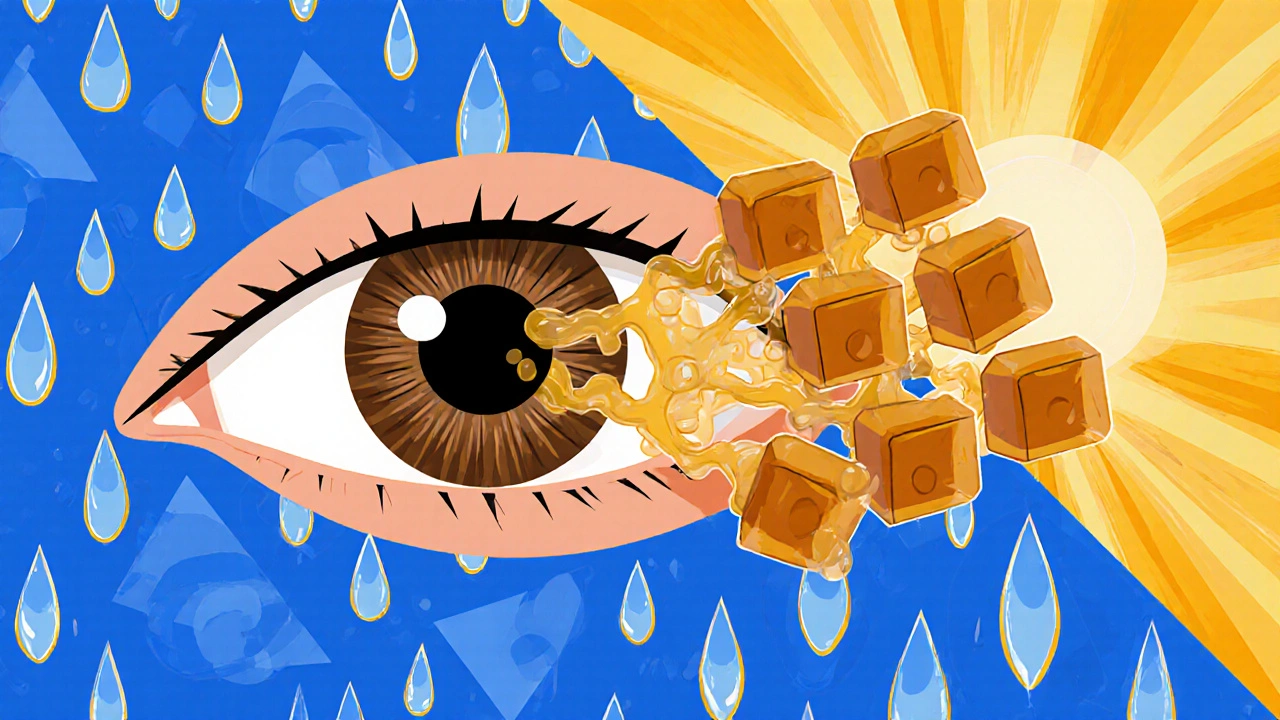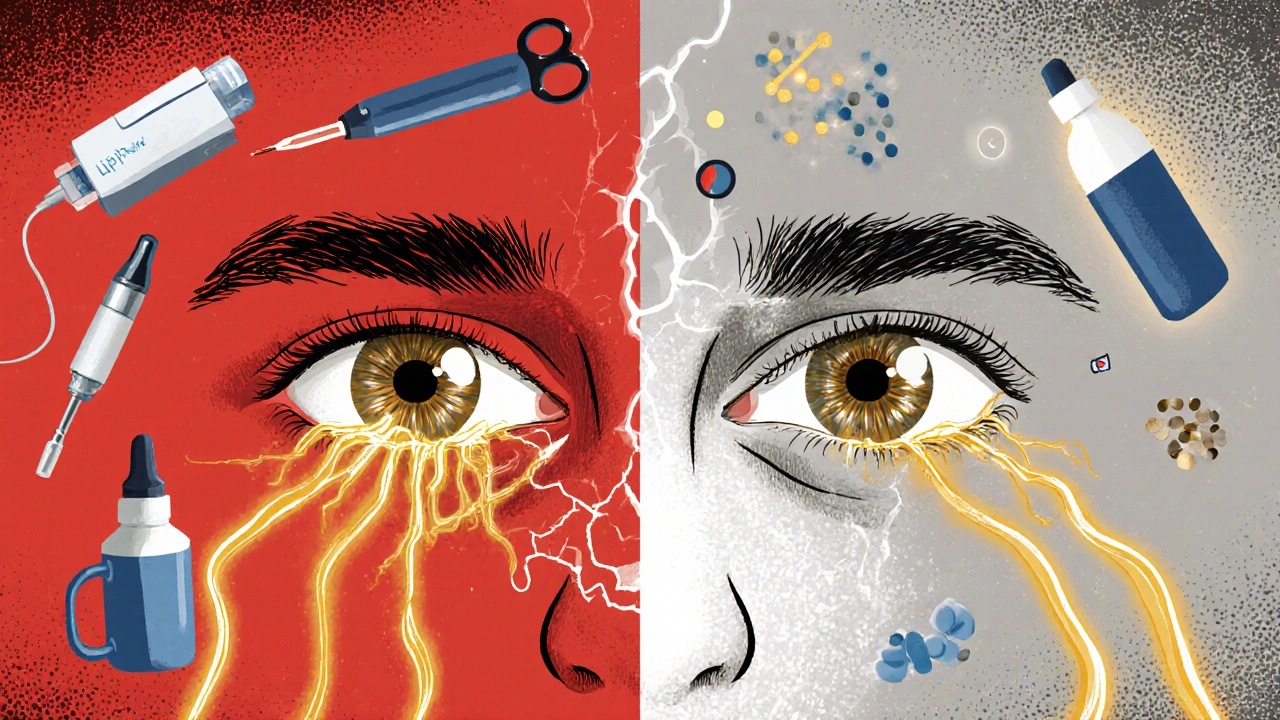SEARCH
Ocular Surface Disease: Effective Care for Meibomian Gland Dysfunction


What Is Meibomian Gland Dysfunction?
Meibomian gland dysfunction, or MGD, is the most common cause of dry eye disease. It happens when the tiny oil glands in your eyelids - called meibomian glands - get blocked or stop working right. These glands make the oily layer of your tear film, which keeps your eyes from drying out. When they’re clogged, your tears evaporate too fast, leaving your eyes burning, gritty, red, or watery. It’s not just discomfort - untreated MGD can lead to corneal damage and even vision problems over time.
About 86% of people diagnosed with dry eye have MGD. It gets worse with age, and if you spend hours on screens, wear contacts, or live in dry or windy climates, your risk goes up. In fact, nearly half of all patients visiting an eye doctor show signs of MGD. It’s not rare. It’s common. And most people don’t realize they have it until symptoms get bad.
Two Types of MGD - And Why It Matters
Not all MGD is the same. There are two main types: obstructive and hypersecretory.
Obstructive MGD is the most common. The glands are physically blocked - like a clogged pipe - so no oil comes out. This is often caused by thickened oil, inflammation, or scar tissue around the ducts. It’s what you see in people who have crusty eyelids in the morning or feel like sand is in their eyes.
Hypersecretory MGD is less common. Here, the glands make too much oil, but it’s poor quality - watery, not thick and smooth. This oil doesn’t spread properly over the eye, so it still evaporates. It’s often linked to skin conditions like rosacea.
Knowing which type you have changes your treatment. One-size-fits-all approaches don’t work. If you’re getting only warm compresses and it’s not helping, you might have a deeper blockage that needs more than heat.
Home Care: The Foundation of MGD Treatment
No fancy procedure will fix MGD if you skip the basics. Daily home care is non-negotiable. The standard routine takes 10 to 15 minutes a day and includes three steps: heat, massage, and clean.
- Heat: Use a warm compress or a Bruder mask heated to 40-42°C. Heat melts the hardened oil in the glands. Do this for 5-10 minutes. Don’t just use a hot towel - it cools too fast. A reusable heated mask keeps consistent warmth.
- Massage: After heating, gently press along your eyelids from the outer corner toward your nose. This pushes the melted oil out. Use your clean fingertip or a cotton swab. Do it on both upper and lower lids.
- Clean: Use a lid scrub with hypochlorous acid (like OCuSOFT Lid Scrub) to remove debris and bacteria. This reduces inflammation and keeps glands from clogging again.
Studies show you need at least 85% compliance to keep symptoms under control. Miss a few days, and the oil thickens again. People who stick to this routine see results in 4-6 weeks. Those who quit after a month? Symptoms come back fast.
In-Office Treatments: What Actually Works
If home care isn’t enough, doctors have tools that go deeper. Three treatments have solid evidence behind them: LipiFlow, IPL, and meibomian gland probing.
LipiFlow is a device that heats the inside of your eyelids while massaging them. It’s FDA-cleared, takes about 12 minutes per eye, and works best for obstructive MGD. Studies show 68% of patients with blocked glands see better oil flow after one session. But it costs $1,500-$2,500 per eye, and insurance rarely covers it.
IPL (Intense Pulsed Light) uses pulses of light to target blood vessels near the eyelids that cause inflammation. It’s usually done in four sessions, three weeks apart. Each session takes 15 minutes. When combined with manual gland expression, IPL cuts OSDI scores (a dry eye symptom scale) from 32 to 18 on average. It’s less expensive than LipiFlow - around $800-$1,200 per session - but still out-of-pocket for most.
Meibomian Gland Probing (MGP) is for advanced cases. A thin probe is inserted into each gland to break up deep blockages. It’s done under local numbing and takes about 40 minutes. It’s not for everyone - it’s for people with long-standing MGD, scar tissue, or gland dropout. One study found combining MGP with heat and anti-inflammatories led to 85% sustained improvement at one year.
Medications: When Pills and Drops Help
Medications aren’t the first line, but they’re key when inflammation is the main problem.
Oral azithromycin is a 5-day course: one 500 mg pill on day one, then 250 mg daily for four more days. It’s more effective than doxycycline - 78% of patients saw less redness, compared to 62% on doxycycline. It also has far fewer side effects: only 3% had nausea or stomach issues, versus 29% on doxycycline. It’s cheap, short, and works well.
Topical lifitegrast (Xiidra) is a prescription eye drop that reduces inflammation. It’s used twice a day and helps people with advanced MGD. One study showed corneal staining - a sign of surface damage - dropped from 12.4 to 5.7 after 12 weeks. It doesn’t fix blockages, but it stops the damage.
Do not use steroid drops long-term. They can raise eye pressure and cause cataracts. Use them only under doctor supervision for short flares.
Why Some Treatments Fail - And What to Do Instead
Many people try LipiFlow or IPL once, feel better for a few months, then go back to square one. Why? Because they stop the home care.
Dr. Preeya Gupta, a cornea specialist, says: “Without daily warm compresses and lid hygiene, recurrence rates hit 60% within six months.” That’s the truth. In-office treatments are like fixing a leaky pipe - but if you don’t clean the pipes every day, they clog again.
Another issue: treating MGD too late. If you wait five years to get help, your glands may be permanently damaged. Studies show patients treated within the first year have 37% better outcomes than those who wait. Early detection matters.
And not all clinics are equal. Make sure your provider uses meibography (a special imaging test) to see your gland structure. If they don’t, they’re guessing. You deserve real data.

Cost, Insurance, and Real-World Challenges
The biggest barrier? Money.
LipiFlow costs up to $5,000 for both eyes. IPL runs $3,000-$4,800 for a full course. Meibomian gland probing is $750-$1,200 per session. Most insurance plans - including Aetna and UnitedHealthcare - classify these as “experimental” or “investigational.” Only 15-20% of claims get approved.
On Reddit and patient forums, the same story repeats: “I spent $2,000 and got relief for 4 months. Now I’m back to burning eyes.” People feel trapped: they can’t afford treatment, but they can’t live with the pain.
Some clinics offer payment plans. Others accept HSA/FSA funds. Ask. And if you’re eligible for clinical trials, sign up - new treatments like exosome therapy are being tested right now.
What’s Next? Emerging Therapies
Science is moving fast. New treatments are in the pipeline.
Exosome therapy - using tiny biological particles to repair damaged tissue - showed 92% symptom improvement in early trials, compared to 76% with standard care.
Nanomicellar cyclosporine (Cequa) delivers medication deeper into the eye with 35% better absorption than older drops.
And in 2023, experts updated guidelines to recommend treating MGD even before cataract surgery - because untreated MGD leads to more post-op inflammation and blurry vision.
Researchers are also studying the IL-17 pathway, which may lead to biologic drugs that target inflammation at its source.
Bottom Line: You Can Manage MGD - But You Have to Stay Consistent
MGD isn’t curable. But it’s manageable. You don’t need to spend thousands. You don’t need to wait for insurance to cover it. Start today: heat, massage, clean - every single day.
If symptoms persist, see a dry eye specialist, not just your general optometrist. Demand meibography. Ask about azithromycin. Consider IPL if you have rosacea. Don’t accept “just use artificial tears” as an answer.
People who stick with the routine get their lives back. They sleep better. They read without strain. They wear contacts again. It’s not magic. It’s mechanics. And you’re in control of the steps.
Is meibomian gland dysfunction the same as dry eye?
Not exactly. Dry eye is a broad term for when your eyes don’t make enough tears or the tears evaporate too fast. Meibomian gland dysfunction (MGD) is the leading cause of dry eye - responsible for 86% of cases. MGD specifically means your oil glands are blocked or not working right, which causes the tear film to break down. So while all MGD causes dry eye, not all dry eye is caused by MGD.
Can I treat MGD with just artificial tears?
No. Artificial tears add moisture, but they don’t fix the root problem: blocked oil glands. Without the oily layer, your tears evaporate even faster. Using drops alone is like putting a bandage on a broken pipe - it helps temporarily, but the leak keeps happening. You need heat, massage, and cleaning to restore the oil layer.
How long does it take to see results from home care?
Most people notice improvement in 4 to 6 weeks with daily warm compresses, lid massage, and cleaning. But it takes consistency. If you skip days, the oil thickens again. Some feel better sooner - especially if they combine home care with a short course of oral azithromycin. Don’t give up before six weeks.
Are in-office treatments worth the cost?
For many, yes - if you’ve tried home care for 3-6 months with no improvement. LipiFlow, IPL, and gland probing can provide significant relief, especially for moderate to severe MGD. But they’re not magic bullets. Without daily home care afterward, symptoms return in 6-12 months. Think of them as a reset button, not a cure. Weigh the cost against your quality of life - if you can’t read, drive, or work comfortably, it may be worth it.
Does MGD get worse with age?
Yes. As you get older, your meibomian glands naturally produce less oil and the secretions thicken. Studies show MGD affects over 50% of people over 60. Screen time, medications, and environmental factors make it worse. The earlier you start care, the better your long-term outcomes. Waiting until your 70s means your glands may already be permanently damaged.
Can I use a regular heating pad for MGD?
Not safely. Regular heating pads get too hot - up to 60°C or more - and can burn your eyelids. They also cool down too fast. Use a medical-grade heated mask like the Bruder Mask, which holds 40-42°C for 10 minutes. That’s the sweet spot: warm enough to melt oil, safe enough to avoid burns.
Is MGD linked to rosacea?
Yes, strongly. Up to 60% of people with facial rosacea also have MGD. The same inflammation that causes red cheeks and nose bumps also affects the eyelids. If you have rosacea and dry eyes, treat both together. IPL therapy often helps both conditions at once.
Should I get MGD treated before cataract surgery?
Yes - even if you have no symptoms. The 2023 Dry Eye Workshop II guidelines now recommend treating MGD before cataract surgery. Untreated MGD increases post-op inflammation, delays healing, and can lead to blurry vision after surgery. Treating it first improves outcomes and reduces complications.